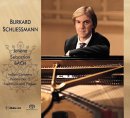|
|
K-3 |
J.S. Bach: Italian Concerto; Partita No. 2; Fantasias and Fugues |


|
|
Partita No. 2 in C minor, BWV 826 [22.03]*
Italian Concerto in F major, BWV 971 [12:24]*
Fantasia & Fugue in A minor, BWV 904 [7:55]**
Fantasia, Adagio (in G major, BWV 968) & Fugue in C minor, BWV 906 [11:16]**
Chromatic Fantasia & Fugue in D minor, BWV 903 [12:19]* |
|
Burkard Schliessmann (Piano) [Piano: Steinway & Sons, D-274, # 588.201, property of Burkard Schliessmann; Technical Handling / Tuning / Intonation: Georges Ammann, Steinway & Sons] |
|
Divine Art DDC-25751 |
*Aug 14, 2012
**Apr 23, 2013 |
SACD / TT: 65:58 |
|
Recorded at Teldex-Studios Berlin, Germany.
Recording Producers: Friedemann Engelbrecht, Tobias Lehmann; Sound Engineer: Julian Schwenkner; Editing: Julian Schwenkner.
One of the masterpieces from Bach’s years of maturity is the Fantasia in C minor BWV 906 that was written towards the end of the 1730s. Here Bach explores the world of Neapolitan keyboard music created by Alessandro and Domenico Scarlatti, one of the principal effects of which was the crossing of the performer’s hands. Succinct in terms of its motivic and thematic writing and filled with a sense of intense motoric urgency, the Fantasia reflects its composer’s engagement with Classical sonata form. The first subject-group is followed by a much calmer episode that serves as a second subject, while the development section gives way to a foreshortened recapitulation. It is regrettable that the ensuing fugue remained unfinished – or at least it has come down to us in only an incomplete form. Wholly unique, it is cast, rather, in the form of a fantasia and sets out to explore a world of such unprecedented novelty that we might be forgiven for thinking that this was an experimental study rather than a piece intended for publication: note, in particular, the bold chromatic progressions and examples of contrary motion, to say nothing of the work’s audacious harmonic writing. Whereas the first part of the fugue is unquestionably by Bach, the authorship of the second, more diffuse, section is uncertain. Ferruccio Busoni completed the fugue, extending its original forty-seven bars to ninety-six with a display of contrapuntal mastery. In order to achieve the inner cohesion of a three-movement sonata-like work, he also interpolated between the Fantasia and Fugue the Adagio in G major BWV 968 that Bach himself had arranged from his Third Sonata for unaccompanied violin BWV 1005. The source of this arrangement is an autograph manuscript by Johann Christoph Altnickol headed "SONATA per il CEMBALO Solo del Sigre J. S. Bach", although, stylistically speaking, the arrangement tends, rather, to point in the direction of the generation of Bach’s sons, notably Wilhelm Friedemann Bach. But it is possible that the arranger was Altnickol himself. Whatever the answer, the arrangement is a fine example of the way in which a violin piece could be adapted for a keyboard of the time. The low register of the writing may be due to the fact that the following movements of the violin sonata were also intended to be transcribed without violating their melodic line, but it may also be an argument in favour of the use of a particular instrument such as a lute-harpsichord.
© Burkard Schliessmann |
|
|